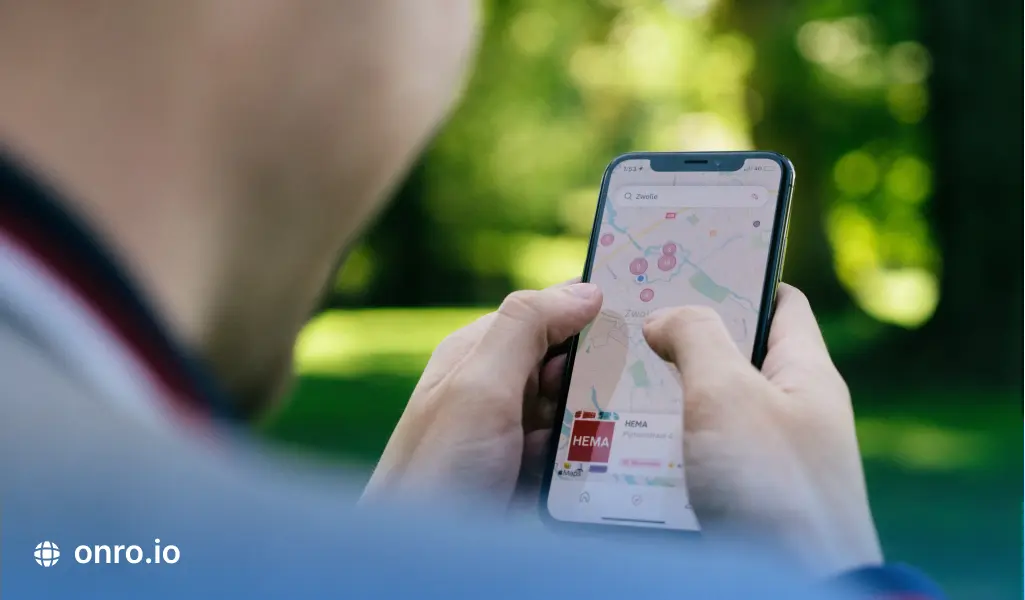Starting a Roadside Assistance Business is starting a service that assists stranded drivers with towing, tire changing, jump starts, and any other roadside service assistance they might need.
Key Takeaways
-
The roadside assistance market is growing and projected to reach $44.67B by 2034.
-
Before you even launch, you should have a clear business vision, market research, and legal structure.
-
Essential services include towing, tire changes, fuel delivery, and lockout support.
-
Fleet setup requires GPS-equipped tow trucks, repair tools, and regular maintenance.
-
Being able to push a button and get a ride in real-time with a mobile app adds a level of trust, speed, and reliability for consumers.
-
Growth will come from digital marketing, local SEO, and partnerships with insurers or auto shops.
-
Controlling costs related to fleets, competition, and licenses will ensure long-term success.
Thinking of starting a roadside assistance business? With market demand soaring due to rising vehicle usage and growing tech-driven needs, there has never been a better time to seize the opportunity. From towing to emergency support, roadside assistance is important. Follow this trusted step-by-step approach to launch a successful roadside business with a sense of confidence and clarity, and learn how on demand delivery software can help to have the best service.
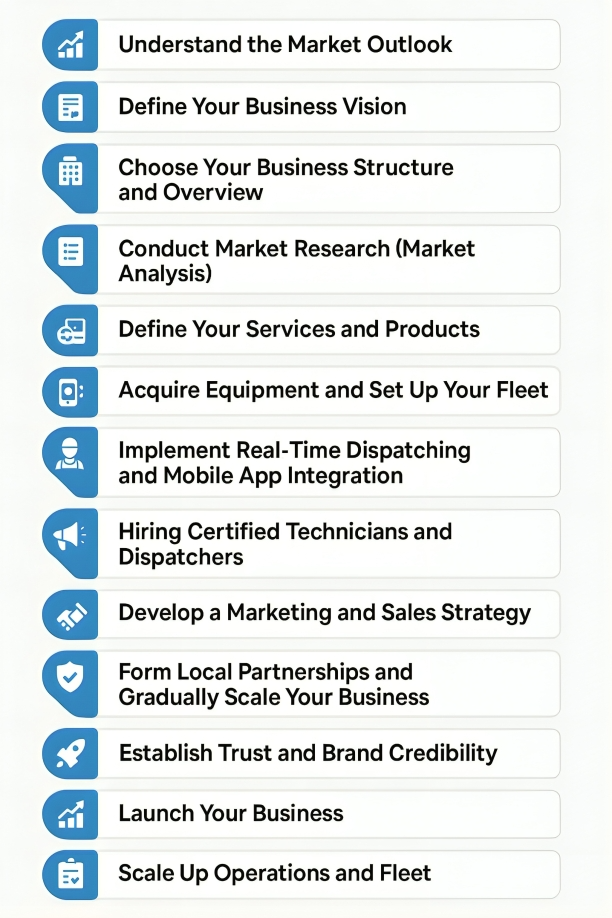
Try Onro for Free
Get your free access to the Onro White-label On-demand Delivery Software.
How to Start a Roadside Assistance Business?
Follow these steps to launch and grow your roadside assistance business.
Step 1. Roadside Assistance Market Outlook
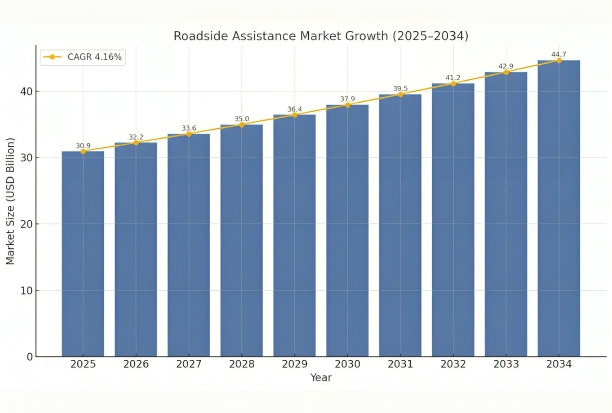
As the bar chart shows, it is forecast to increase from around 30.95 billion USD in 2025 to almost 44.67 billion USD by 2034. On the other hand, this market is growing annually at 4.16%. Different factors affect this, such as the rise in urban living, vehicles being sold, older fleets requiring support, and an increased demand for emergency roadside services.
In Europe, the roadside business market continues to be strong. Because in European countries infrastructure is well-established. Also, this market is growing in North America because of weather conditions and aging vehicles.
With the rise of technology, EV assistance, and the growing service types and insurance coverage. Also, assistance services are spreading their wings. Passenger vehicles and OEMs offer these services due to affordability, warranty options, and system integration.
Step 2. Define Your Business Vision
You should present an executive summary. This must be a summary of the business concept of your roadside assistance company, the principal objectives, the target market, and how it is competing so that it grabs the attention of the reader right away.
Step 3. Choose Your Business Structure and Overview
Describing your company mission, describing the legal entities (Limited Liability Company), partnership, etc. under which your company operates, and giving an overview of your plan for growth and service excellence are all very important. This is important to start deploying business models.
Step 4. Conduct Market Research (Market Analysis)
Research into the demand for roadside assistance services in your area by studying customer demographics, market size, trends, and principal competitors.
Step 5. Define Your Services and Products
The company needs to provide detailed descriptions of its services so that potential customers can know exactly what they get when ordering. These services might include towing, tire changes, lockout assistance, and fuel delivery. There has to be a comparison of their reliability and uniqueness. For instance, having the best dispatch software can optimize journeys to assistance more efficiently with the aid of route optimization.
Step 6. Acquire Equipment and Set Up Your Fleet to Start Roadside Business
Tow trucks of light, medium, and heavy types, as well as various tow-gadgets like jacks, tire repair kits, battery jump-starters, hydraulic equipment, and towing accessories must be available for the functioning of roadside assistance services.
For efficient dispatching and perfect fleet management, install GPS on all vehicles to have real-time tracking systems. Regular vehicle maintenance is crucial to prevent service delays.
Step 7. Implement Real-Time Dispatching and Mobile App Integration for Roadside Assistance
Set up an dispatching software integrated with the mobile application. The platform must allow GPS route optimizations in real-time and good communication between the driver and the customer.
The 24/7 emergency roadside customer support should be maintained for emergencies. The development of a custom roadside assistance app with a strong backend will help process service requests efficiently.
Step 8. Hiring Certified Technicians and Dispatchers for Roadside Assistance
Roadside repair-and-towing service operations which one must hire well-trained mechanics with pertinent certification (for example, by ASE). All dispatchers are to be trained in the use of GPS and the operations of service routing. Moreover, emergency roadside services call-taking operations are to be taken into consideration.
Try Onro for Free
Get your free access to the Onro White-label On-demand Delivery Software.
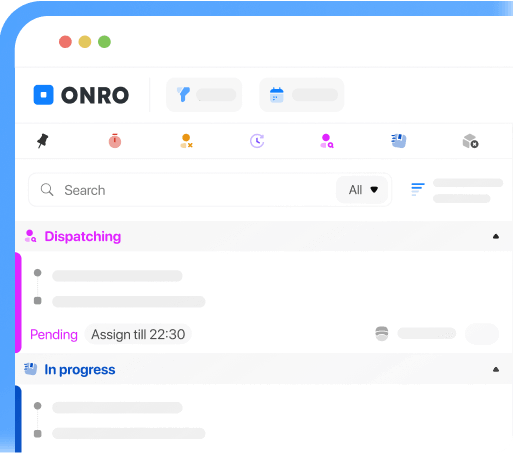
Step 9. Develop a Marketing and Sales Strategy
While digital marketing and so-called sales tactics grow your roadside assistance business, it would be great to incorporate pay-per-click marketing and search engine optimization (SEO) into your entire marketing canvas, generating online visibility and increasing rank in local results.
Don’t forget about advertising ideas to boost your business awareness. Promote via mobile websites for roadside assistance, top-notch local SEO with the help of active social media pages for customer interaction and viewing of services: Facebook, Instagram, and LinkedIn.
Step 10. Form Local Partnerships and Gradually Scale Your Business
This higher outreach could indeed suggest partnerships with local businesses such as insurance companies, gas stations, or body shops. The idea will be to generate referrals and build good community-level brand recall.
Step 11. Establish Trust and Brand Credibility
Establishing trust with the customer is equally important. List down positive reviews to enhance your credibility. Have professional certification, maintain the highest level of service from one platform to the next, and ask for customer retention.
Step 12. Launch Your Business
True roadside services are always delivered when a proper daily management system is instated. There must be standard operating procedures (SOPs) that have been written on the matter covering dispatch, response time, service protocols, and emergency handling.
Job descriptions for dispatchers, technicians, and customer care will have to be well-outlined in terms of responsibilities. A fleet GPS tracking system must be applied with real-time communication to monitor the locations of vehicles and dispatch the nearest vehicle to the customer’s location.
Define geographical coverage zones so that resources can be arranged to support vehicle breakdowns at peak times. Vehicles should always be maintained and serviced. Moreover, technicians should be certified to carry out guaranteed service.
Step 13. Scale Up Operations
Financial monitoring will help keep control of expenses and investing in growth. Keep high-level information on revenues, expenses, profit margin, and cash flows on a monthly basis. Ensure that accounting software is used for accuracy and report preparation. Conduct analysis so that the exact time at which the business will be profitable is known.
Initial costs for purchasing equipment and upgrading the technology need to be considered. Account for every source of incoming cash into the business: a loan or a grant, or an investor’s investment. A financial consultant, specializing in small business management, might possibly be of help.
Step 14. Manage Daily Operations and Fleet
Describe daily operation service procedures, response time, employee job roles, fleet management, and geography coverage.
Step 15. Monitor Finances and Plan Growth
Present financial forecasts in detail, including revenues expected to come in, expenses expected to be incurred, cash flow analyses, break-even costs, and funding requirements for start-up and growth.
Common Challenges When Starting a Roadside Assistance Business and How to Overcome Them
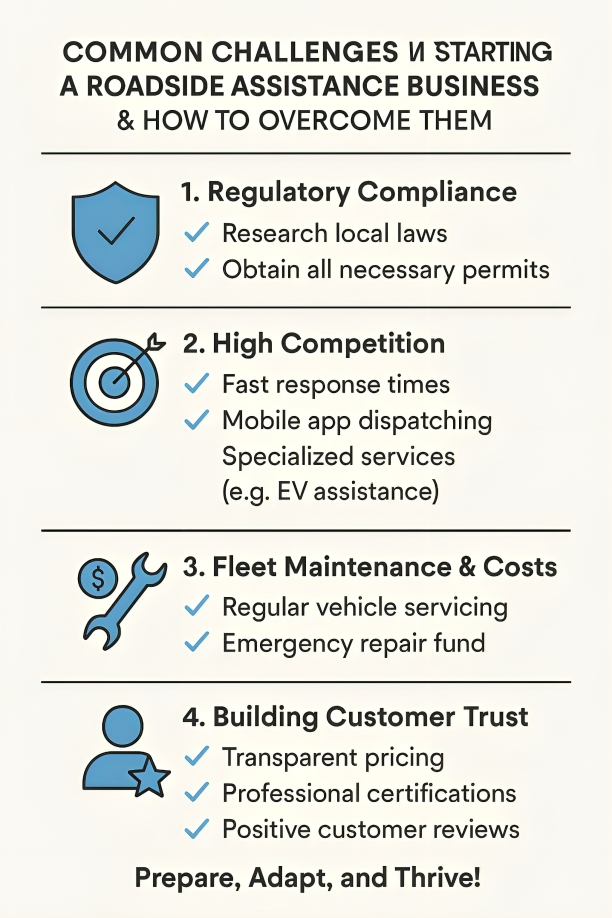
Some challenges may be faced when beginning and managing a roadside assistance business. If one knows these challenges beforehand, one may prepare oneself and erect a stronger enterprise:
Regulatory Compliance
Every territory has its regulations and requirements for licensing towing and roadside services. Failure to comply will attract penalties and hefty fines, or such charges might lead to the closure of businesses. Hence, you should research all local laws applicable to your service and procure permits to operate beforehand.
Overcrowded Market
The roadside assistance line of business may be overcrowded. To build a good reputation, you may have to emphasize fast response time, perhaps for mobile app-based dispatching, or offer niche services such as EV assistance or luxury car towing.
Fleet Maintenance and Costs
Your fleet is the most important asset of your business. Unplanned maintenance or breakdown might wreck the availability of your assistant and will tarnish the good name of your company. Keep a strict time maintenance schedule and never fail to put funds aside for emergencies.
Gaining Customer Trust
Roadside assistance is rendered during situations that may stress a potential assistance seeker. Potential client’s trust companies that use transparent price-fixing procedures, have professional certifications, and prove their reliability. You should collect positive reviews from clients and certifications and proudly display them.
FAQ | Start a Roadside Assistance Business
Tow trucks, tire repair kits, jump starters, GPS tracking systems, and any other accessories related to towing must be available to provide an overall service.
Costs of startup businesses range from $10,000 to $150,000, depending on the number of fleets, equipment needed, and employees to be hired.
The businesses are indeed profitable. Depending on whether there is always demand, especially in cities and cold climates, one can expect recurring revenue to be provided through roadside assistance and grow really fast if steered with the correct means.
Yes, you should. All states, or countries, require permits, insurance, and certification. Always observe your local law before beginning.
Depending on promotions, local SEO could be a good start, along with PPC ad campaigns, mobile applications, social media, and potential industry partners such as insurers, auto repair shops, and gas stations.
Conclusion
Starting roadside assistance usually demands some sort of business plan, a healthy operational aspect, and, of course, customer appeal. The dispatch of techniques, marketing, and promotions, all these are feeding the kind of sturdy foundation that gets erected. Right now, if you want to win in this ever-changing market, this is the opportunity. Take that first step toward setting up your own roadside business. Ready to start a roadside business the smart way? Try Onro for a free demo. Onro is the best all-in-one dispatch and fleet management solution.
Try Onro for Free
Get your free access to the Onro White-label On-demand Delivery Software.



